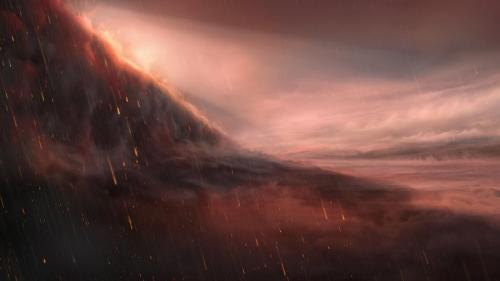Fictional Space Mission/alternative History

Fictional space mission/alternative history
Another artwork in Cosmonaut series. This time it’s cosmonaut on Ganymede, largest moon of Jupiter.
Prints of this and other artworks are available in my deviantART.com and society6.com shops.
More Posts from Starlost and Others


shit man this got me emotional
Why is there something here, instead of nothing? And why are we aware of this question—we people, particles going around and around this black stone? Why are we aware of it?
Annie Dillard, from For the Time Being (Alfred A. Knopf, 1999)
Date the boy of the infinite. He who swirls and twists outside of time. Outside of space. He who would stop the ticking of the clock for you, to spend an eternity with you. He who would turn back the dial, to have another moment before you are gone. Always there, but always not.

The horizons of Venus, Earth, Moon, Mars, and Titan.
Source: http://i.imgur.com/A1gIYXdl.jpg
sometimes before i go to sleep, i like to get my cellphone, put my headphones on, play city lights by blanche and close my eyes and pretend that i am just floating on a rock in the outer space, all alone in the danger zone
Solar System: Things to Know This Week
Like sailors of old, the Cassini mission team fondly thinks of the spacecraft as “she." On April 22, she begins her Grand Finale, a spectacular end game—22 daring dives between the planet’s atmosphere and innermost rings. Here are 10 things to know about her Grand Finale.

1. She’s Broadcasting Live This Week
On Tuesday, April 4 at 3 p.m. EDT (noon PDT), At Jet Propulsion Laboratory, the Cassini team host a news briefing to discuss the mission’s Grand Finale.
Tune in Tuesday: youtube.com/nasajpl/live

2. She’s Powered in Part By … Titan
Cassini left Earth with less than 1/30th of the propellant needed to power all her adventures at Saturn. The navigation team used the gravity of Saturn’s giant moon Titan to change course and extend the spacecraft’s exploration of Saturn. Titan also provides the gravity assist to push Cassini into its final orbits.
More on Cassini’s navigation: saturn.jpl.nasa.gov/mission/spacecraft/navigation/

3. She’s a Robot
Cassini is an orbiter that was named for 18th century astronomer Giovanni Domenico Cassini. She was designed to be captured by Saturn’s gravity and then explore it in detail with a suite of 12 powerful science instruments.
More on the Spacecraft: saturn.jpl.nasa.gov/mission/spacecraft/cassini-orbiter/

4. She Brought a Friend to Saturn
Cassini carried the European Space Agency’s Huygens Probe, which in 2005 descended through Titan’s thick, perpetual clouds and made the most distant landing to date in our solar system.
More on Huygens: saturn.jpl.nasa.gov/mission/spacecraft/huygens-probe/

5. She’s a Great Photographer
Your mobile phone likely captures dozens of megapixels in images. Cassini, using 1990s technology closer to one megapixel cameras, has returned some of the most stunning images in the history of solar system exploration.
Cassini Hall of Fame Images: go.nasa.gov/2oec6H2 More on Cassini’s Cameras: saturn.jpl.nasa.gov/imaging-science-subsystem/

6. She’s an Inspiration
Those great images have inspired artist’s and amateur image processors to create truly fantastic imagery inspired by the beauty of Saturn. Feeling inspired? There’s still time to share your Cassini-inspired art with us.
Cassini Inspires Campaign: saturn.jpl.nasa.gov/mission/cassiniinspires/

7. She’s Got a Long History
Two decades is a long time to live in the harsh environment of outer space (respect to the fast-approaching 40-year-old twin Voyager spacecraft). Launched in 1997, Cassini logged a lot of milestones over the years.
Explore the Cassini Timeline: saturn.jpl.nasa.gov/the-journey/timeline/

8. She Keeps a Diary
And, you can read it. Week after week going back to 1997, Cassini’s adventures, discoveries and status have been chronicled in the mission’s weekly significant events report.
Read It: https://saturn.jpl.nasa.gov/news/?topic=121

9. She’s Got a Fancy New App
Cassini was the prototype for NASA’s Eyes on the Solar System 3-D visualization software, so it’s fitting the latest Cassini module in the free, downloadable software is the most detailed, elaborate visualization of any mission to date.
Fly the Mission - Start to Finish: http://eyes.nasa.gov/cassini

10. She’s Going Out in a Blaze of Glory
In addition to all the new information from 22 orbits in unexplored space, Cassini’s engineers reprogrammed the spacecraft to send back details about Saturn’s atmosphere to the very last second before the giant planet swallows her up on Sept. 15, 2017.
More on the Grand Finale: saturn.jpl.nasa.gov/grandfinale
Discover more lists of 10 things to know about our solar system HERE.
Make sure to follow us on Tumblr for your regular dose of space: http://nasa.tumblr.com



Molten iron rain falls through the skies of scorching-hot exoplanet
WASP-76b is a hot Jupiter exoplanet discovered during 2013 that can be found in the constellation Pisces. It orbits a F-type star (WASP-76) and has a size 0.92 that of Jupiter’s mass. In March 2020, it was speculated the temperature on the planet could reach 2,400 °C on the hot side, hot enough to vaporize neutral iron. If the night side of WASP-76b had temperatures down to at least 1,400 °C, the iron may condense then rain down as hot liquid iron on its surface.
The atmosphere of WASP-76b is cloudy and mostly grey, with a significant amount of thermal incandescence.
Ten interesting facts about Pluto
Here is a list of some interesting facts about Pluto. A dwarf planet with a very different geology than previously thought, and despite being a small celestial body - Pluto has its own moons.

Pluto was known as the smallest planet in the solar system and the ninth planet from the sun until it was reclassified by the International Astronomical Union in 2006.

Today, Pluto is called a dwarf planet. A dwarf planet orbits the sun just like other planets, but it is smaller. It is large enough for its gravity to pull it into the shape of a ball but it is too small to clear other objects and debris out of its path around the sun.

Pluto was discovered on February 18th, 1930 by the Lowell Observatory. For the 76 years between Pluto being discovered and the time it was reclassified as a dwarf planet it completed under a third of its orbit around the Sun.

On average, Pluto is more than 3.6 billion miles (5.8 billion kilometers) away from the sun. That is about 40 times as far from the sun as Earth is. Pluto orbits the sun in an oval like a racetrack. Because of its oval orbit, Pluto is sometimes closer to the sun than at other times. At its closest point to the sun Pluto is still billions of miles away but is actually closer than Neptune.

This dwarf planet has five moons. Its largest moon is named Charon (KAIR-uhn). Charon is about half the size of Pluto.

Pluto has four other, much smaller, moons. They are named Nix, Hydra, Kerberos, and Styx. They were discovered in 2005, 2005, 2011, and 2012, respectively. NASA’s Hubble Space Telescope took pictures of the new moons. All four are small.

Observations of Pluto’s surface by the New Horizons spacecraft revealed a variety of surface features, including mountains that reach as high as 11,000 feet (3,500 meters), comparable to the Rocky Mountains on Earth. While methane and nitrogen ice cover much of the surface of Pluto, these materials are not strong enough to support such enormous peaks, so scientists suspect that the mountains are formed on a bedrock of water ice.

Pluto’s surface is one of the coldest places in the solar system, at roughly minus 375 degrees Fahrenheit (minus 225 degrees Celsius). When compared with past images, pictures of Pluto taken by the Hubble Space Telescope revealed that the dwarf planet had apparently grown redder over time, apparently due to seasonal changes.

When Pluto is closer to the sun, its surface ices thaw and temporarily form a thin atmosphere, consisting mostly of nitrogen, with some methane.

Pluto’s low gravity, which is a little more than one-twentieth that of Earth’s, causes this atmosphere to extend much higher in altitude than Earth’s.
sources: solarsystem.nasa and space.com
image credit: NASA/JPL - Lowell Observatory Archives

-
 oihvgci liked this · 1 year ago
oihvgci liked this · 1 year ago -
 labelleizzy liked this · 2 years ago
labelleizzy liked this · 2 years ago -
 loony-paranoid-star liked this · 3 years ago
loony-paranoid-star liked this · 3 years ago -
 cid006 liked this · 3 years ago
cid006 liked this · 3 years ago -
 missrupy liked this · 3 years ago
missrupy liked this · 3 years ago -
 outpostzero liked this · 4 years ago
outpostzero liked this · 4 years ago -
 spacerhombus3000 liked this · 4 years ago
spacerhombus3000 liked this · 4 years ago -
 ashdudesworld liked this · 4 years ago
ashdudesworld liked this · 4 years ago -
 wakayume liked this · 4 years ago
wakayume liked this · 4 years ago -
 frogshunnedshadows liked this · 4 years ago
frogshunnedshadows liked this · 4 years ago -
 percyruss liked this · 4 years ago
percyruss liked this · 4 years ago -
 iwanteverythinginworld liked this · 4 years ago
iwanteverythinginworld liked this · 4 years ago -
 animeandspace reblogged this · 4 years ago
animeandspace reblogged this · 4 years ago -
 ammon-rah liked this · 5 years ago
ammon-rah liked this · 5 years ago -
 tigersbloodmantis liked this · 5 years ago
tigersbloodmantis liked this · 5 years ago -
 poothtaste reblogged this · 5 years ago
poothtaste reblogged this · 5 years ago -
 dontworryaboutme23-blog liked this · 5 years ago
dontworryaboutme23-blog liked this · 5 years ago -
 oneworldforeverwithyou2 liked this · 5 years ago
oneworldforeverwithyou2 liked this · 5 years ago -
 oneworldforeverwithyou2 reblogged this · 5 years ago
oneworldforeverwithyou2 reblogged this · 5 years ago -
 frostgar liked this · 6 years ago
frostgar liked this · 6 years ago -
 yesswimmingtimetravelcollectorus liked this · 6 years ago
yesswimmingtimetravelcollectorus liked this · 6 years ago -
 terran-cr reblogged this · 6 years ago
terran-cr reblogged this · 6 years ago -
 varyoe reblogged this · 6 years ago
varyoe reblogged this · 6 years ago -
 inspiration-42 liked this · 6 years ago
inspiration-42 liked this · 6 years ago -
 deadinsidebutitsokay reblogged this · 6 years ago
deadinsidebutitsokay reblogged this · 6 years ago -
 deadinsidebutitsokay liked this · 6 years ago
deadinsidebutitsokay liked this · 6 years ago -
 sasagedai liked this · 6 years ago
sasagedai liked this · 6 years ago -
 str8bk428 liked this · 6 years ago
str8bk428 liked this · 6 years ago -
 some1-in-this-big-world liked this · 6 years ago
some1-in-this-big-world liked this · 6 years ago -
 astral-22 liked this · 6 years ago
astral-22 liked this · 6 years ago -
 0-alonearmy-0-blog liked this · 6 years ago
0-alonearmy-0-blog liked this · 6 years ago -
 thenperishdotexe-blog liked this · 6 years ago
thenperishdotexe-blog liked this · 6 years ago -
 palaniswa liked this · 6 years ago
palaniswa liked this · 6 years ago -
 punk-rock-attitude liked this · 6 years ago
punk-rock-attitude liked this · 6 years ago -
 lustandlimerence-blog reblogged this · 6 years ago
lustandlimerence-blog reblogged this · 6 years ago -
 asliceren5-blog liked this · 6 years ago
asliceren5-blog liked this · 6 years ago -
 rope-doc-13 liked this · 6 years ago
rope-doc-13 liked this · 6 years ago -
 anti-thesh reblogged this · 6 years ago
anti-thesh reblogged this · 6 years ago -
 neeeeerrrrrd liked this · 6 years ago
neeeeerrrrrd liked this · 6 years ago

andrei, he/him, 21, made this at 14 when i was a space nerd but i never fully grew out of that phase so,,,,..,hubble telescope + alien life + exoplanet + sci fi nerd
245 posts